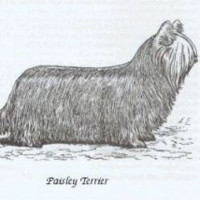 |
Paisley Terrier |
|
He is not recognized by the F.C.I. |
Origin |
Scotland | |
Translation |
Francis Vandersteen |
| The Paisley Terrier is a descendant of its ancestor, the Skye Terrier, with a similar temperament and appearance. Records from 1440 use the word terrier, telling us that the Skye Terrier was not the first of this group, although we have little evidence from before the Skye Terrier. In French, "Terrier" is translated as "Chien Terre", which translates as "Earth Dog". This is appropriate for terriers as they were bred and used to catch rats and small rodents in the ground. There are records to show that the terrier group already existed in the 10th century, and experts say they existed long before that. Remains of what is thought to be the Skye Terrier, or a terrier-like dog, have been discovered at an archaeological dig site in Scotland, proving the presence of terriers in Roman times, both in England and Scotland. Burrows in those days would have been used in the same way as today, hunting the small animals that burrow beneath the earth. Nothing is known for certain about the origin of terriers, probably because many of the farmers who bred them were illiterate, and no registers of dog breeds were kept during this period. Some say terriers were first bred and used by Celtic tribes, while others believe they came after the Celtic tribes in the same place. Most agree that terriers originated in the British Isles, as they were only known outside Britain 200 years later. Many believe that terriers are descended from British breeds such as the Scottish Deerhound, Canis Segusius and the Irish Wolfhound, although this has never been proven. Farmers preferred small terriers because of their ability to chase small vermin away from their crops and livestock. This avoided possible animal disease and also prevented small rodents from eating or ruining plants. Because people were poor and hungry in those days, terriers were strictly kept as working dogs, not as pets or companions. A common practice was to put the terrier and an otter or badger together in a barrel so that the terrier could prove that it was worthy of being a working dog. If the terrier killed the other animal, it was then taken by the farmer to become a working dog. In those days, terriers had a stiff coat, unlike the Skye Terrier, which had a silkier coat. The Skye Terrier was found on an island north of the Highlands, in the Hebrides. This breed had a longer body and was most likely crossed with the Corgis that also inhabited the island. Skye Terriers were considered both working and companion dogs, particularly in Scotland, where they became one of the country's most popular breeds in the 1800s. Shortly afterwards, the Industrial Revolution in Scotland slowly ended the demand for small working dogs. Now, Skye Terriers are bred as companion dogs, and sometimes travel with their owners to factories to kill small rodents in the buildings. Because they are now bred for companionship, people would prefer dogs with brighter, more attractive coats. By the mid-19th century, Skye Terriers had been reproduced to the point of being called Clydesdale (located in the town of Clydesdale) or Paisley Terriers (located in the town of Paisley, near Glasgow). The two names (Clydesdale and Paisley Terrier) alternated throughout the decade. At the same time as the Clydesdale became popular, dog shows also began to become a popular sport in Europe. Compared to Skye Terriers, judges preferred Clydesdales because of their long, silky coats. For this reason, they were bred to further improve the length and quality of their coats. Apart from dog shows, the Paisley Terrier was mostly preferred by women who didn't want a stuffed dog. The Industrial Revolution continued through the 1800s, leading immigrants to travel to other countries, taking their Paisley Terriers with them and eventually breeding with other terriers, again altering the appearance of Clydesdales. Some were bred to have shorter backs, while others were bred to prefer their long, silky hair. Eventually, a famous dog called Huddersfield Ben became the standard for Paisley Terriers, making versions of all towns named otherwise. This includes a modern version of the Yorkshire Terrier and today's Lancashire Terrier. These two dogs also had different offspring. With these new breeds developed in other countries and cities, demand for the Paisley Terrier declined. Over time, the Yorkshire Terrier overcame most of the other terrier breeds and continues to be popular today. The Paisley Terrier was bred until the early 1900s, but there is no trace of the breed after the First World War. |






 English (United Kingdom)
English (United Kingdom)